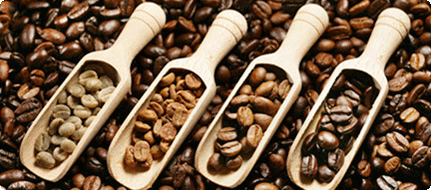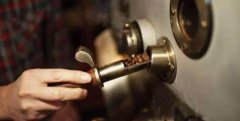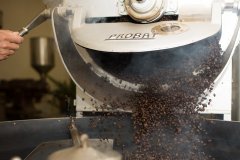Factors affecting the depth of baking: color and weight loss

For professional baristas, please follow the coffee workshop (Wechat official account cafe_style)
Lightly fried beans contain more acid, so they are suitable for areas where alkaline water is used. Lower-grade coffee beans have poor taste characteristics, which can be easily revealed by shallow stir-frying. So usually we use deep stir-fry to drive away the bad volatiles in the beans.
Mixing beans that have already been baked has many advantages. Habit and local people's favorite taste usually determine the depth of fried beans. In cities, fried beans are usually deeper than usual, just like what we call "urban stir-frying". This kind of stir-frying, which is shallower than French frying and does not have any overheated characteristics, is a raw material often used by coffee manufacturers to prepare instant coffee. Because more carbohydrates are made into aqueous solutions in the factory filtration process than brewing coffee at home, more carbohydrate flavors must be balanced by deep stir-frying.
The color of roasted coffee beans has a certain relationship with the percentage of roasted weightlessness.
Light to medium stir-fried like cinnamon, when it first entered the range of delicious coffee, the weight loss was about 14%.
Baking that is dark brown but not all black will lose about 15.5% of its weight.
The deepest roasting with a slightly black tint of brown will lose about 17% of its weight, which is the most commonly used and deepest stir-frying method in the United States.
Individual stir-frying, such as French-fried coffee, is very dark brown and has oil on the surface of the beans, with about 18% weightlessness.
The Italian style of frying is very dark brown, with a weightlessness of about 20%.
In all cases, let's assume that raw beans are about 12% moisture. The amount of water-soluble matter in different coffees varies at 212 degrees Fahrenheit (100 degrees Celsius), but deep frying reduces the production of extracts. For example, in medium frying, the degree of weightlessness of 15% will produce 23% of the extracted solution. However, when the same coffee beans are fried to 18% weightlessness, only 21% of the extracted solution will be produced. The hydrolysates that are of interest to instant coffee manufacturers will also be reduced in deep frying. By the same token, the range of hydrolyzed solutes can be 25 to 22%. In other words, the sum of all reduced extracts and hydrolyzed solutes is 48% to 43%. This has a great impact on the real solution that can be obtained by cooking coffee. Cooking lightly fried beans produces 38% of the solution, while cooking lightly fried beans produces 35% of the solution. Deep-fried beans will have greater damage to the cell wall and powerful structure, so they have better compressibility. For this reason, deep fried beans under compression and more pressure will leak from the bottom of the coffee filter more often than shallow fried beans. Deep fried beans are also fragile, and there are more fine powders during grinding. These finer powders also put more pressure on each drop of coffee or make the extraction more resistant. Although the above coffee weightlessness is important, it is less measurable. It is possible to identify eight colors from the lightest to the darkest with the naked eye. These speculation methods are as follows:
Light Roast extremely shallow baking
Cinnamon Roast cinnamon / shallow baking
Baking in Medium Roast
Medium and deep baking in High Roast
City Roast deep baking
Full City Roast very deep baking
French Roast French baking
Italian Roast semantic baking
When roasting with a mixture of different coffee or different coffee beans, and want to use the depth of roasting to control the ideal taste, you need to test frequently. Mixed shallow fried beans show different special tastes than single deep fried beans. Deep-fried beans release more fatty acids and their extracts, which can make coffee have more coffee flavor. When coffee beans are removed from the roaster, cooling with water will increase the moisture of the coffee beans and deepen the color on the surface of the coffee beans, so dry and wet coffee beans can not be compared together.
Important Notice :
前街咖啡 FrontStreet Coffee has moved to new addredd:
FrontStreet Coffee Address: 315,Donghua East Road,GuangZhou
Tel:020 38364473
- Prev

Coffee roasting | changes in the properties of coffee beans during roasting
Communication of professional baristas Please pay attention to the stir-frying process in the coffee workshop (Wechat official account cafe_style). It is the main process of heating raw beans and developing the aroma and taste of coffee. The aroma and taste emitted are determined by the original characteristics of each kind of raw bean. The depth of fried beans depends on the type of raw beans, market demand or cooking methods. What kind of baking machine controls the depth of fried beans
- Next

How to control the three processes of baking: drying, high temperature decomposition and cooling
Professional baristas Please pay attention to the coffee shop (official Wechat account cafe_style) the newly imported coffee beans are usually about 12% moisture, and when the coffee beans are roasted at a high roasting temperature from 500F to 800F, the water evaporates when the beans are heated. Most of the moisture is released in the first few minutes of the baking process, although the baking time in the United States is usually about
Related
- Beginners will see the "Coffee pull flower" guide!
- What is the difference between ice blog purified milk and ordinary milk coffee?
- Why is the Philippines the largest producer of crops in Liberia?
- For coffee extraction, should the fine powder be retained?
- How does extracted espresso fill pressed powder? How much strength does it take to press the powder?
- How to make jasmine cold extract coffee? Is the jasmine + latte good?
- Will this little toy really make the coffee taste better? How does Lily Drip affect coffee extraction?
- Will the action of slapping the filter cup also affect coffee extraction?
- What's the difference between powder-to-water ratio and powder-to-liquid ratio?
- What is the Ethiopian local species? What does it have to do with Heirloom native species?

